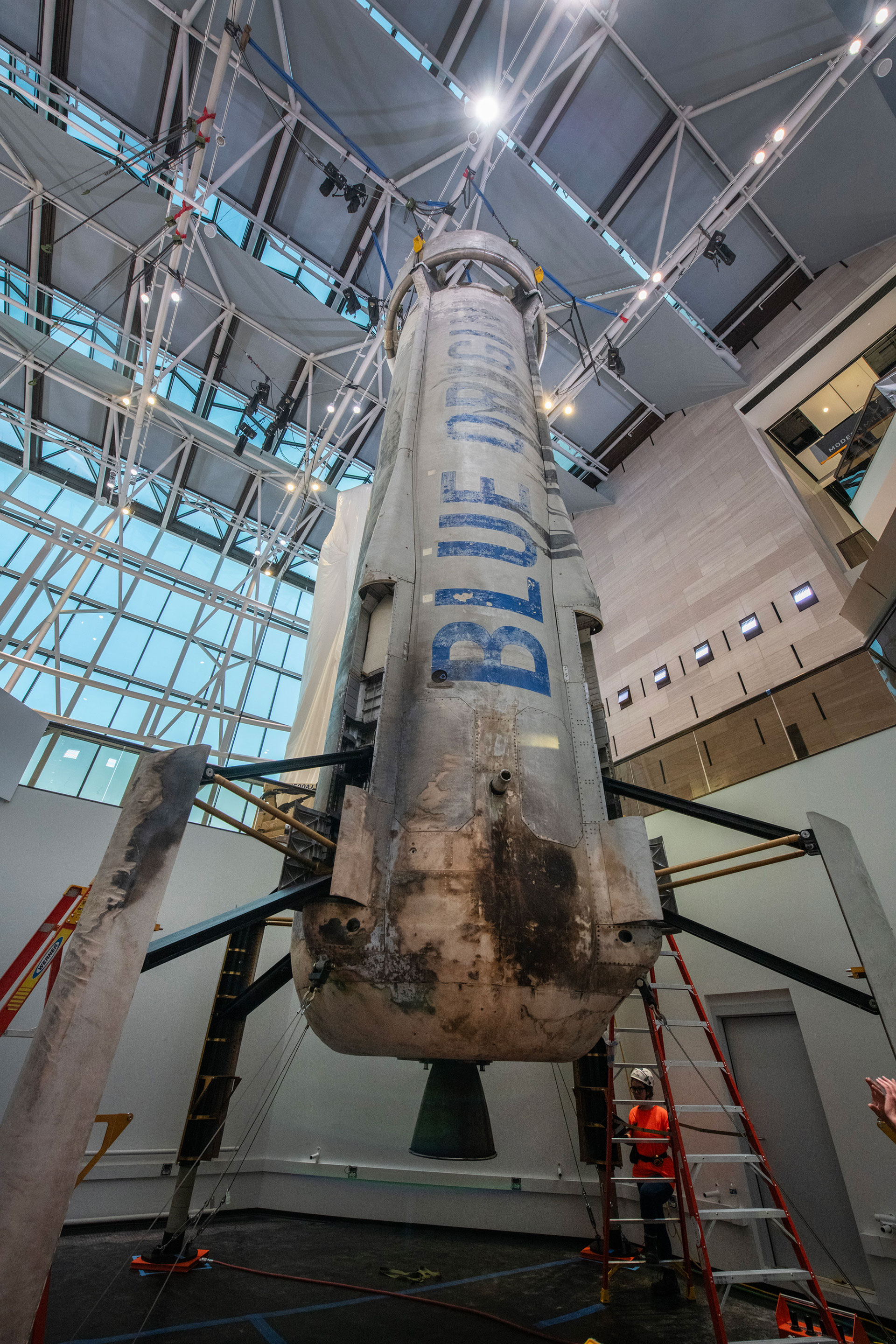Blue Origin founder Jeff Bezos once pledged that if his company’s first rocket to reach space and land vertically back on Earth survived an abort test then he would “reward it for its service” by putting it into a museum.
Eight years later, Bezos has made good on that promise and then some.
“There is no better final landing pad for New Shepard than the Smithsonian,” said Bezos in a statement. “We are honored and grateful.”
The New Shepard booster that became the world’s first launch vehicle to place a payload into space before landing upright on its legs has been delivered to the Smithsonian. Further, a mockup of Blue Origin’s crew capsule will go on display at the same time as the rocket at the National Air and Space Museum, to later be replaced by by the still-flying “RSS First Step,” the spacecraft that has flown 43 people to space (to date), including Bezos himself.
The Blue Origin artifacts will debut to the public in two renovated and reimagined galleries opening in the museum’s Washington, D.C. flagship building in 2026.
“The New Shepard rocket and capsule represent current spaceflight and future exploration,” said Chris Browne, director of the museum, in a statement. “A key component of the museum’s ongoing transformation is having a rich collection and presentation of what’s happening right now, in addition to celebrating incredible feats of the past.”
Related: Facts about Jeff Bezos, Blue Origin and Amazon founder
Propulsion Module (PM) 4-2, or “Tail 2,” as Blue Origin refers to its second New Shepard booster to be built and flown, will be exhibited in the museum’s “missile pit,” standing alongside a V-2, Minuteman II and a full-scale replica of the Jupiter-C launch vehicle that put the United States’ first satellite into orbit. As part of the new “RTX Living in the Space Age” gallery, the five-time flown New Shepard rocket will help explain to visitors the “how, why and who of the ways in which the Space Age has transformed our lives.”

The New Shepard crew capsule, which can seat up to six private astronauts for a 10-minute trip above the Kármán line and back, will join “Futures in Space,” an exhibition themed around the “potential near- and long-term futures that may emerge with advances in space exploration technology and enterprise.” The Air and Space Museum is using the gallery to showcase developing technologies that are reducing the cost of access to space, beginning the era of commercial spaceflight and expanding robotic resource extraction to worlds beyond Earth.
“We are excited to welcome these milestone artifacts into our collection and display them in our upcoming galleries,” said Browne.
Tail 2 did not launch people, but lifted off on four suborbital test flights between November 2015 and June 2016. Each time, it lofted the first New Shepard capsule, named the “RSS Jules Verne.”
Since Oct. 5, 2016, when it beat the odds and survived a test of the crew cabin’s escape system, Tail 2 has been exhibited by Blue Origin at various company functions, including an employee holiday party in 2016; at MARS 2017, Amazon’s annual invite-only robotics-focused gathering; at the Space Foundation’s Space Symposium in Colorado Springs; and at EAA Airventure, the Experimental Aircraft Association’s fly-in in Oshkosh, Wisconsin in July 2017. It then “landed” in the lobby of Blue Origin’s New Glenn orbital rocket factory at NASA’s Kennedy Space Center in Florida in 2018, where it has been until now.

“RSS First Step” is Blue Origin’s first and, to date, only New Shepard capsule to launch passengers. Among its more notable crew members have been “Mercury 13” member Wally Funk; “Star Trek” actor William Shatner; and Laura Shepard Churchley, daughter of the first American in space Alan Shepard, for whom Blue Origin named the vehicle.
Blue Origin is now preparing for the first launch of its second human-rated vehicle, the “RSS Kármán Line,” named after the internationally recognized boundary between Earth and space. The vehicle is comprised of the fourth module and fifth propulsion module to fly.

In addition to Blue Origin’s capsule and rocket donations, Bezos personally gifted the Smithsonian $200 million in 2021, in part to support the renovation of the National Air and Space Museum and to establish a new education center at the museum.
The Bezos Learning Center, to be housed in a separate facility on the east side of the museum’s plaza on the National Mall, will feature programs aimed at engaging students in science, technology, engineering, arts and mathematics, as well as aid educators in better using the Smithsonian’s collections across all of its museums.
Follow collectSPACE.com on Facebook and on Twitter at @collectSPACE. Copyright 2024 collectSPACE.com. All rights reserved.
